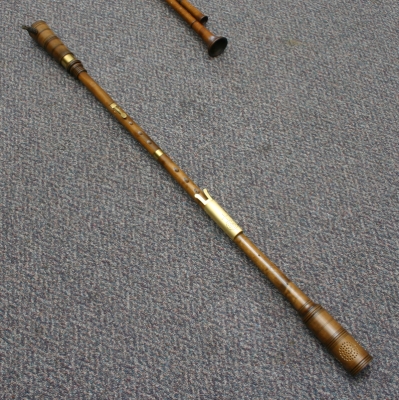
bout the Cornamuse
 The cornamuse is wind-cap instrument that is closely related to the crumhorn.
However, the cornamuse lacks the bend that is characteristic of the crumhorn.
Instead of a curve, the instrument is capped by a chamber that gives the instrument a muted tone.
The cornamuse is wind-cap instrument that is closely related to the crumhorn.
However, the cornamuse lacks the bend that is characteristic of the crumhorn.
Instead of a curve, the instrument is capped by a chamber that gives the instrument a muted tone.
No cornamusen survive from the Renaissance, thus our knowledge of them comes from written descriptions and illustrations. Praetorius lists four sizes of cornamusen in his treatise Syntagma Musicum:
- cantus bb to c''
- alto d to e'
- tenor c to d'
- bass F to g
A few years earlier Zacconi mentions a capped shawm in his Prattica di Musica called the dolzaina. It is described as having a range of c to d', or from c to f' if the instrument had keys. Unfortunately, it is not clear whether the dolzaina written about by Zacconi is the same type of instrument that was described by Praetorius. It has been suggested that they are indeed the same instrument and that Zacconi used the term dolzaina to describe the instrument, as the term cornamusa was used to refer to the bag pipe. However, it is also argued that they are different, based on an account of the music at the court in Munich that was made by Massimo Troiano 1568. He states that both dolzaine and cornamusen were played, thus suggesting that they are distinct in more than just their name. It may be that the instruments mentioned by Troiano was not the same as the dolzaina described by Zacconi, thus we cannot be certain.
Fourteenth century writings by Machaut, Eustaches Deschamps, and Juan Alfonso de Baena mention doussaines and dulzainas. A century later Johannes Tinctoris uses the term dulzina as a type of shawm. It is not clear whether the instruments described in these accounts are predecessors of the cornamuse. Although the terms dulzaina and dolzaina are similar, the term dulzian and dulcian were used to refer to the predecessor of the bassoon rather than the cornamuse. Thus, one should be careful in drawing conclusions.
 From the above description it is clear that much of the history of the cornamuse is not known.
What is clear from writings and surviving instruments is that the cornamuse was not as common as its curved cousin the crumhorn.
Both instruments faded into obscurity during the seventeenth century.
From the above description it is clear that much of the history of the cornamuse is not known.
What is clear from writings and surviving instruments is that the cornamuse was not as common as its curved cousin the crumhorn.
Both instruments faded into obscurity during the seventeenth century.
The instrument pictured at the top of this page is a bass cornamuse in F.


Page Design Copyright 2010 Michael Berger
Clip Art Copyright 2002 Dover Publications

